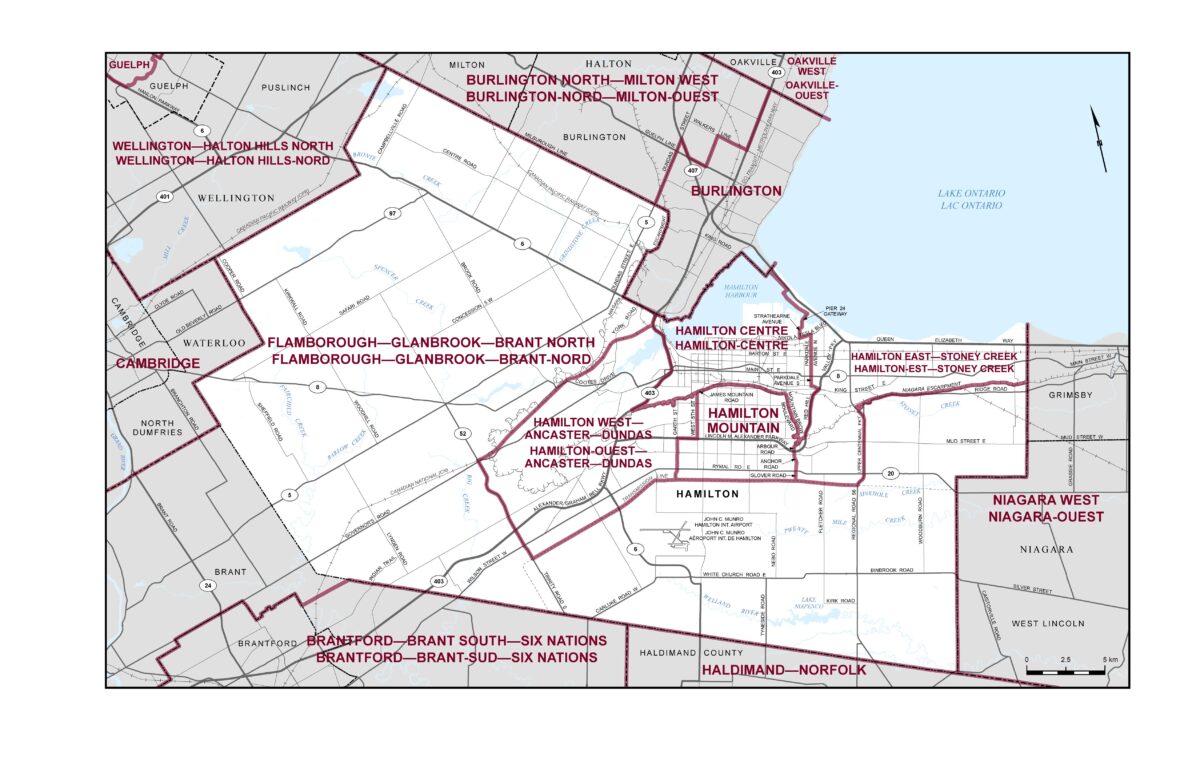When Hamiltonians vote on April 28, a few will do so in different ridings than they did in 2021. That’s because every decade, Canada’s federal electoral boundaries are redistributed.
Four notable changes to Hamilton ridings have been made, all of which favour incumbents. Each party benefits from ‘safer’ boundaries that result in more efficient grouping of party votes—an important consideration in our first-past-the-post electoral system.
Flamborough-Glanbrook goes from competitive to solidly Conservative.
Hamilton Mountain gains over 1000 ‘Liberal’ votes with new subdivisions south of Rymal Road added to the riding, improving the conditions for the Liberals to hold the riding against the NDP.
NDP-leaning polls between Kenilworth and Parkdale avenues are now part of Hamilton Centre, helping to solidify what was already considered a safe seat.
Upper Stoney Creek is added to Hamilton West—Stoney Creek, which marginally helps the Liberal incumbent.
The changes to Hamilton West – Ancaster – Dundas are minor; one subdivision neighbourhood is added.
Flamborough-Glanbrook was Becoming a Contested Riding, Not Anymore With Brant North Added

Green lines denote the new riding boundary, and black lines denote the old riding boundaries. Credit: Redistribution Commission
The most significant change is to the riding of Flamborough-Glanbrook, which becomes Flamborough-Glanbrook-Brant North by taking in portions of the ridings of Cambridge and Brantford-Brant.
Increased urbanization in Binbrook, Upper Stoney Creek, and Waterdown made the old seat more contested with each election cycle. In 2019, the margin was less than 2000 votes with the Liberals spending less than half of what the Conservative incumbent did.

The former riding of Flamborough-Glanbrook is now solidly Conservative with the addition of rural North Brant.
Liberal Polls of Glanbrook Move Into Hamilton Mountain and Hamilton-East Stoney Creek
Hamilton Mountain Gains Newer Subdivisions south of Rymal Road
Hamilton Mountain federally has gone back and forth between the New Democratic Party and the Liberal Party for over 40 years.
The Liberals held it for nearly 20 years during the 1990s until the mid-00s. Liberal infighting between Sheila Copps and Tony Valeri following the 2004 riding redistribution destroyed the Copps campaign machine and left Liberal incumbent Beth Phinney vulnerable. In 2004, the Liberal vote dropped by nearly 4,000 while a resurgent NDP gained 10,000 votes—Phinney held the seat by less than 1000 votes.
Phinney retired before the 2006 federal election.
The NDP won the seat in 2006 and held it for 15 years until 2021.
In 2021, federal NDP headquarters parachuted in an outsider to replace retiring incumbent MP Scott Duvall. NDP infighting cost them the seat with Liberal Lisa Hepfner winning by less than 900 votes.
The NDP candidate for this election is former Member of Provincial Parliament Monique Taylor,
The new riding boundary includes newer subdivisions between Rymal Road and the Hydro One transmission lines.
Population growth in the southern subdivisions is driven by people relocating from the Greater Toronto Area, most of whom vote Liberal.
Formerly in Flamborough-Glanbrook, these polls strongly favoured the Liberals in 2021. The margin in this zone was over 1000 votes, a potentially lucky break for the Liberals.

Green lines denote the new riding boundary, and black lines denote the old riding boundaries. Credit: Redistribution Commission
Upper Stoney Creek added to Hamilton East – Stoney Creek
Upper Stoney Creek is now part of the Hamilton East – Stoney Creek riding. In 2021, as part of Flamborough-Glanbrook, the Upper Stoney Creek polls voted Liberal over Conservative by a close margin of just under 500 votes.
The Upper Stoney Creek polls are willing to vote for any party, as evidenced by the respectable showing for the NDP provincially in 2018 and 2022.
Chad Collins won Hamilton East – Stoney Creek by a margin of over 4,400 votes.

Green lines denote the new riding boundary, and black lines denote the old riding boundaries. Credit: Redistribution Commission
Hamilton Centre NDP Stronghold Made Stronger
Hamilton Centre became a federal riding as part of the 2003 redistribution. Its creation opened an opportunity for the federal NDP to regain a foothold in Hamilton.
The provincial Hamilton Centre seat was one of only 17 seats the Ontario NDP retained during the 1995 provincial election when NDP Premier Bob Rae lost 57 seats in the Legislative Assembly. The NDP held all six Hamilton-area seats going into that election. David Christopherson was the only NDPer left of the six afterwards.
In the 2004 federal election, Christopherson won Hamilton Centre for the federal NDP.
Matthew Green held onto the seat in 2019 for the NDP, following Christopherson’s retirement.
The added neighbourhoods between Kenilworth Street and Parkdale Avenue have been NDP strongholds for decades. Even at the height of the federal Liberal Party dynasty during the 1980s and 1990s, when Sheila Copps dominated Hamilton East, the NDP could win some of these polls.
In 2021, the NDP won the majority of these polls by approximately 900 votes over the Liberals.
These polls will add to Green’s already overwhelming Hamilton margin of over 9,000 votes.
Election Day is April 28
Election Day is April 28. Advance polls will be open April 18-21.
Learn more about voting at Elections Canada.
Production Details
v. 1.0.0
Published: April 6, 2025
Last updated: April 6, 2025
Author: Joey Coleman
Update Record
v. 1.0.0 original version

